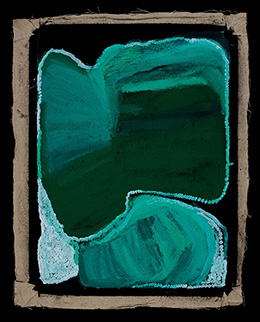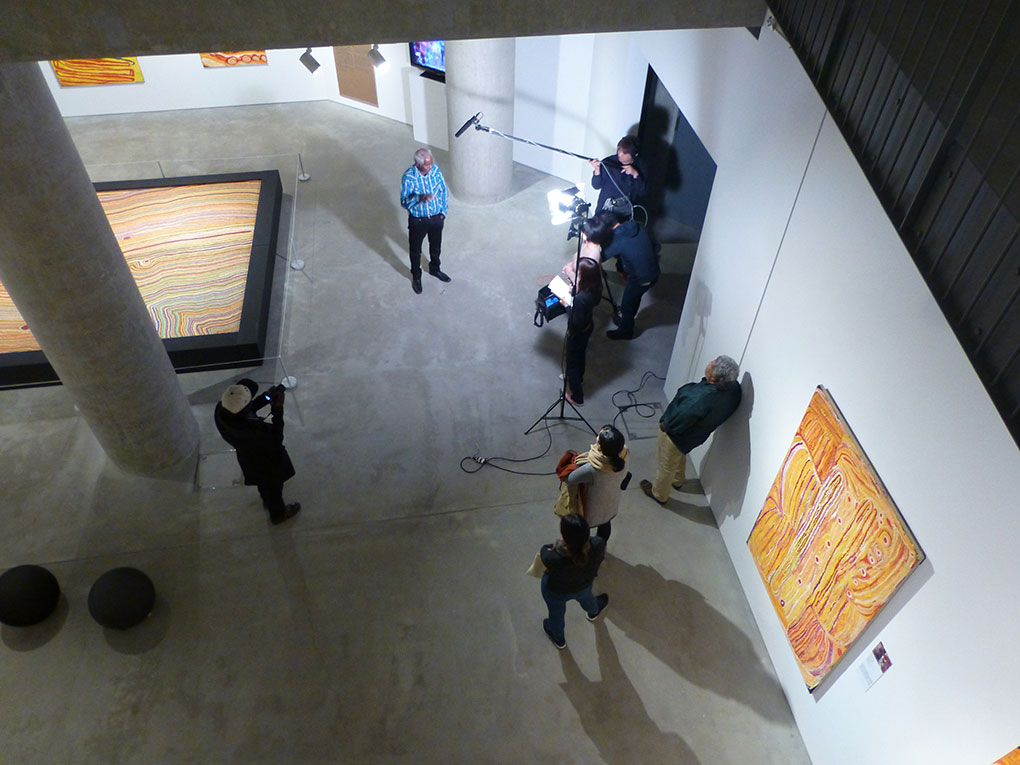3 November 2016
National Museum’s 'One Road' art exhibition moves to Tokyo

Renowned Indigenous artists are visiting Japan for two festival days this month, celebrating the opening of the National Museum of Australia’s One Road: Aboriginal Art from Australia’s Deserts exhibition in Chiba, outside Tokyo.
Artists Curtis Taylor, Mervyn Street and John Nargoodah are in Japan to attend a family festival day on 3 November 2016 at Chiba’s Ichihara Lakeside Museum, where One Road is currently showing.
One Road features 34 paintings drawn from the Canning Stock Route collection and includes works by Australia’s most renowned Aboriginal artists.
On Saturday 5 November and Sunday 6 November 2016, the artists will also attend a two-day autumn festival at Echigo-Tsumari (three hours’ drive north of Tokyo), where a series of panels are being exhibited reproducing Canning Stock Route art from the Museum’s collection.
Curtis Taylor has a film in the One Road exhibition while both Mr Street and Mr Nargoodah worked as stockmen on the Canning Stock Route. Mr Street is represented in the National Museum’s collection.
The artists will participate in painting and print workshops, sand drawing performances, film screenings and talks to showcase the story of the Canning Stock Route to Japanese audiences. They will be accompanied by National Museum senior curator, Dr Michael Pickering.
The artists’ travel is supported by the Australian Government through the Australia-Japan Foundation of the Department of Foreign Affairs and Trade.
'We are very excited to be bringing these three important artists to Japan to allow Japanese audiences to gain further insights into the story of the Canning Stock Route and into Indigenous culture more broadly,' said National Museum director, Dr Mathew Trinca.
'We thank the Australia-Japan Foundation for their support in promoting greater understanding internationally of Australia’s complex history and of the intersection of the Indigenous and non-Indigenous experience,' said Dr Trinca.
The exhibition explores the history of the famous Western Australian droving road (the Canning Stock Route) through the stories of the country it cuts across. Drawing on the works of desert artists and the stories of traditional custodians, the exhibition tells the story of the Canning Stock Route's impact on Aboriginal people, and the importance of the country surrounding it.
The One Road paintings were inspired by a six-week return-to-country trip in 2007.

Artists
Mervyn Street is a Gooniyandi man and an important cultural leader. Mervyn is an accomplished author, illustrator, carver and painter.
John Nargoodah is a Nyikina man. John is a printmaker and etcher who works with younger artists at Mangkaja Arts, teaching the skills of fine lino-carving and etching.
Curtis Taylor is a young Martu leader and filmmaker, whose strengths in traditional Martu and Western knowledge make him a valued cultural facilitator and translator for Martu people. Curtis spent 18 months working on Yiwarra Kuju: The Canning Stock Route as a filmmaker and youth ambassador.
Background: About the Canning Stock Route
The Canning Stock Route is the longest historic stock route in the world. Late 19th century industrial expansion in Western Australia sparked the need for stock routes allowing cattle to be moved from stations in the north to markets in the south. First surveyed in 1906 by Alfred Canning, the route comprised 54 water sources, including 48 constructed wells, spaced at intervals of no more than one day's walk, along an 1800 kilometre stretch of track. The route links Wiluna in the south with Hall’s Creek in the north and traverses the traditional lands of nine Aboriginal language groups.
Although Canning's original map records observations of the land and water resources, it makes no mention of Indigenous places through which the route traversed or their associated meanings.
The development of the ultimately unsuccessful cattle route dramatically affected the lives of Aboriginal people. The National Museum’s collection is the first significant attempt to document the Aboriginal experience of the Canning Stock Route. The collection redresses Canning's omission and records the impact of the stock route on Indigenous lives and country.
The Canning Stock Route collection
This Canning Stock Route collection was acquired in 2009 and includes 116 paintings, sculptural works, contemporary cultural objects, documentary material, and oral histories by 60 artists who travelled along the Canning Stock Route on a return-to-country trip in 2007. This project was initiated by FORM, a not-for-profit arts organisation in Perth.
The six-week journey with traditional owners inspired the artworks, many of which were produced during the journey and provided a unique opportunity for artists to reconnect with traditional lands. The National Museum of Australia regards this collection as one of national significance, providing a unique archive of Indigenous social and cultural histories. It is an important addition to the nation’s heritage and history collections.
For more information please contact Tracy Sutherland (02) 6208 5338/0438 620 710 or media@nma.gov.au
